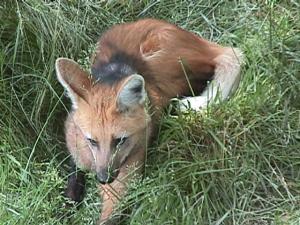
|
Maned Wolf

This uniquely colored wolf has long, soft, reddish yellow fur with dark hair forming an erect mane down its neck and back, a dark muzzle, and dark stockings on its legs and feet. It has large ears and extremely long limbs. At physical maturity, the maned wolf weighs 44 to 51 lb, its head and body measure 49 to 52 inches, and its tail is 11 to 18 inches long. Smaller than true wolves, this species is said to resemble a red fox on stilts. Some scientists have suggested that these extremely long legs are an adaptation for fast running or for traversing swampy ground, but it is more likely that their function is to allow the maned wolf to see above tall grass. The maned wolf is omnivorous with plants making up almost half of its diet; it eats small mammals, lizards, birds, foliage, fruit, and insects; it is also known to take chickens and, very occasionally, newborn lambs and piglets. The maned wolf is not as fast as some other canids, and it does not pursue its prey for long distances. Rather, it stalks and ambushes it prey, usually at night.
Monogamous pairs share a territory averaging 10 sq mi, but they usually hunt alone and rarely associate. Mating peaks in May-June and results in a litter of one to five young (usually two) after a gestation of 62 to 66 days. For reasons unknown, only two pups usually survive to leave the den. Pups are nursed for three to four months and given regurgitated food after the first month. Although maned wolves are sexually mature at one year, they don't breed until their second year. Average life span is 12 to 15 years.
The maned wolf is found in central and eastern South America, including northern Argentina, south and central Brazil, eastern Bolivia, Paraguay, and southeastern Peru. Population figures are not known, but it is believed to occur at low densities in all parts of its range.
A variety of open habitats are utilized, including savanna, grassland, scrubland, swamps, marshes, and agricultural land.
The status of this species has shown recent improvement, but it still faces a number of threats and persecution by people. Disease has been blamed for the decline of the maned wolf population in Bolivia and has often plagued captive breeding attempts. Initial stages of forest clearing for agricultural use may actually be beneficial, but extensive use of land for agricultural purposes may preclude use of that area by maned wolves. Habitat disruption also causes loss of cover and resulting decline or elimination of prey. The maned wolf is not hunted for its fur or meat, but it is frequently killed as a pest, although its reputation as a chicken thief may be exaggerated.
This species is legally protected in Brazil and has been classified as endangered by the Argentine Wildlife Board. Successful captive breeding programs have been established, and reintroduction programs should be explored.
There is a myth that to kill a Maned Wolf brings bad luck.
| TSD, Creating Online Entertainment Since 1988 |
| Copyright © 2007 TSD Inc., All Rights Reserved. |